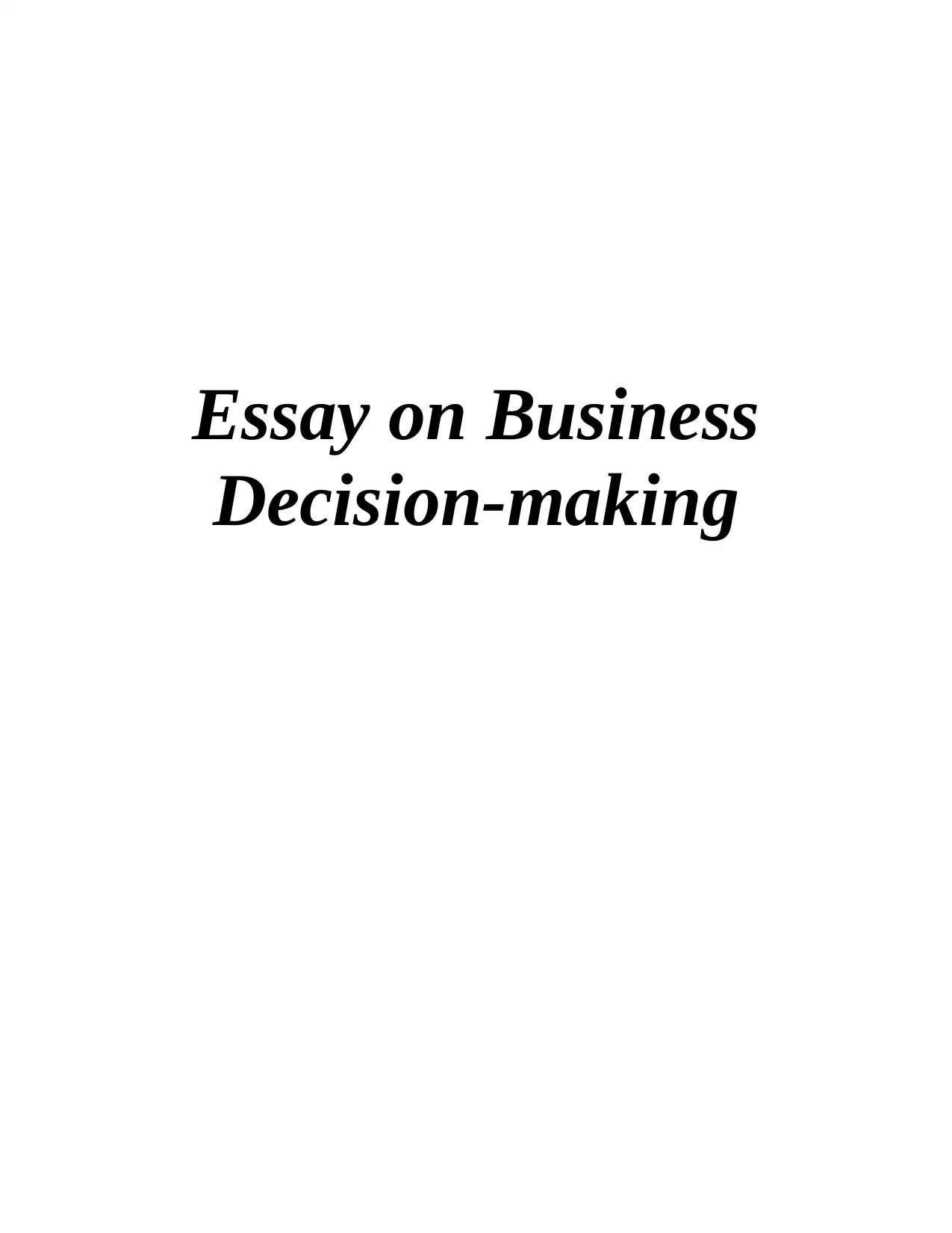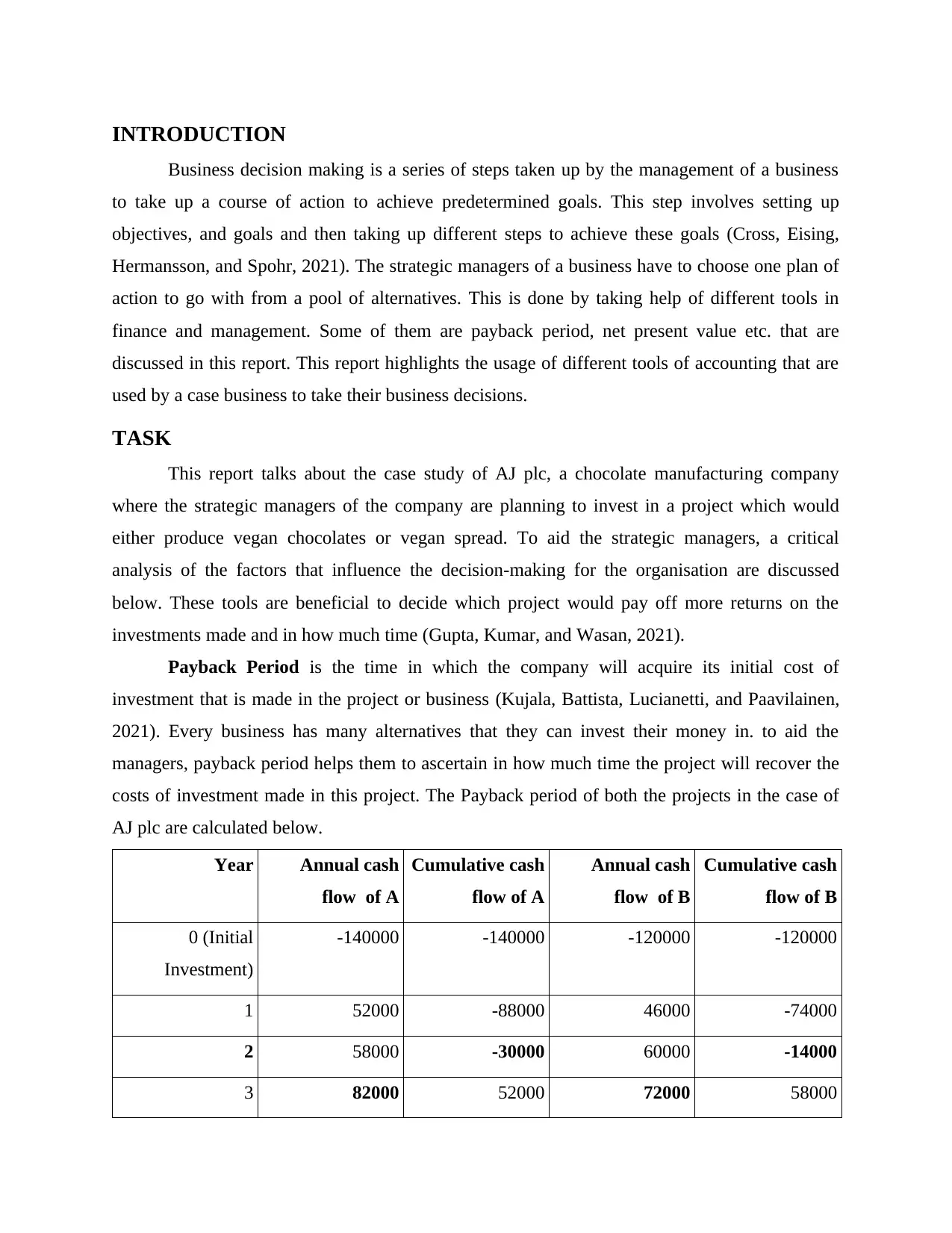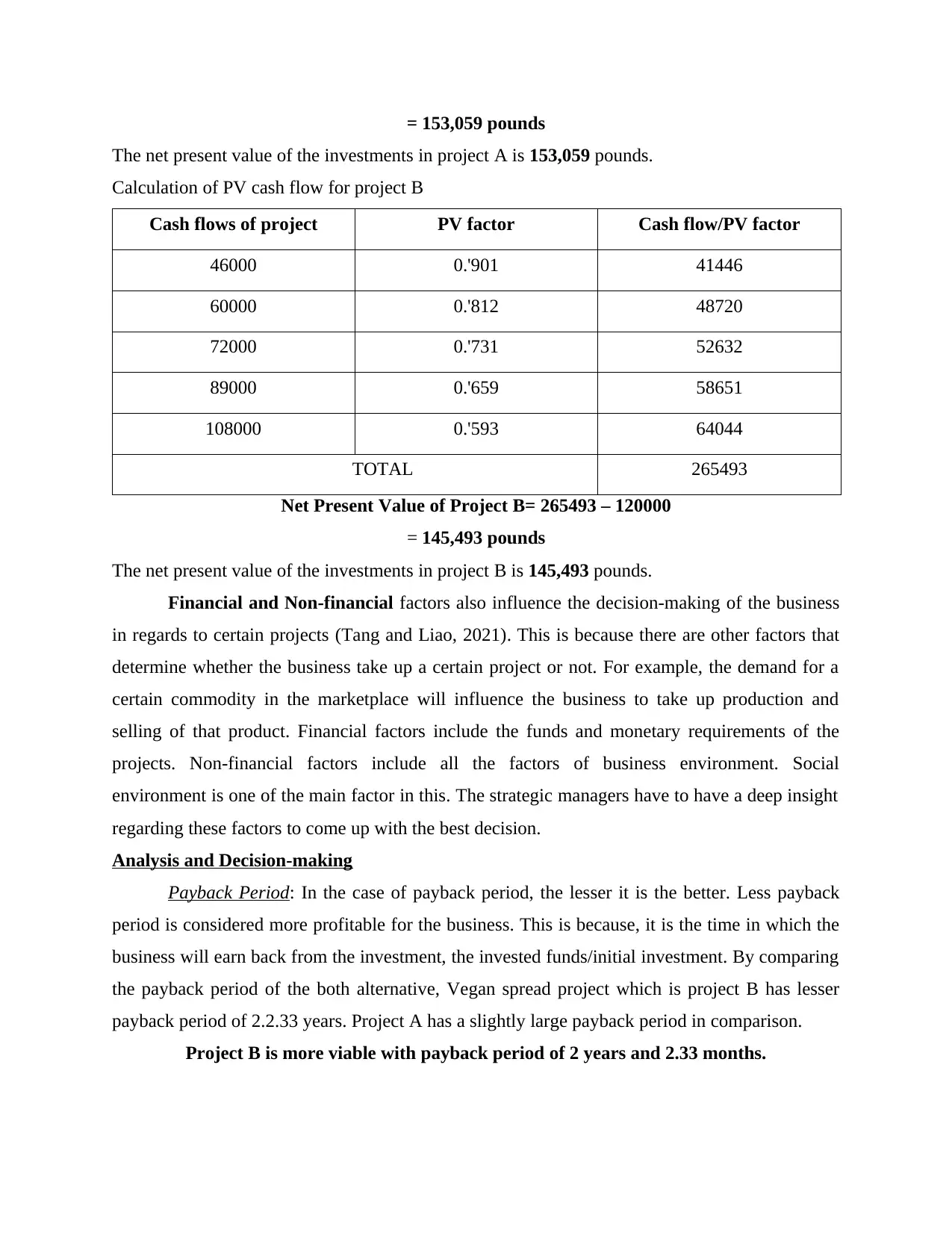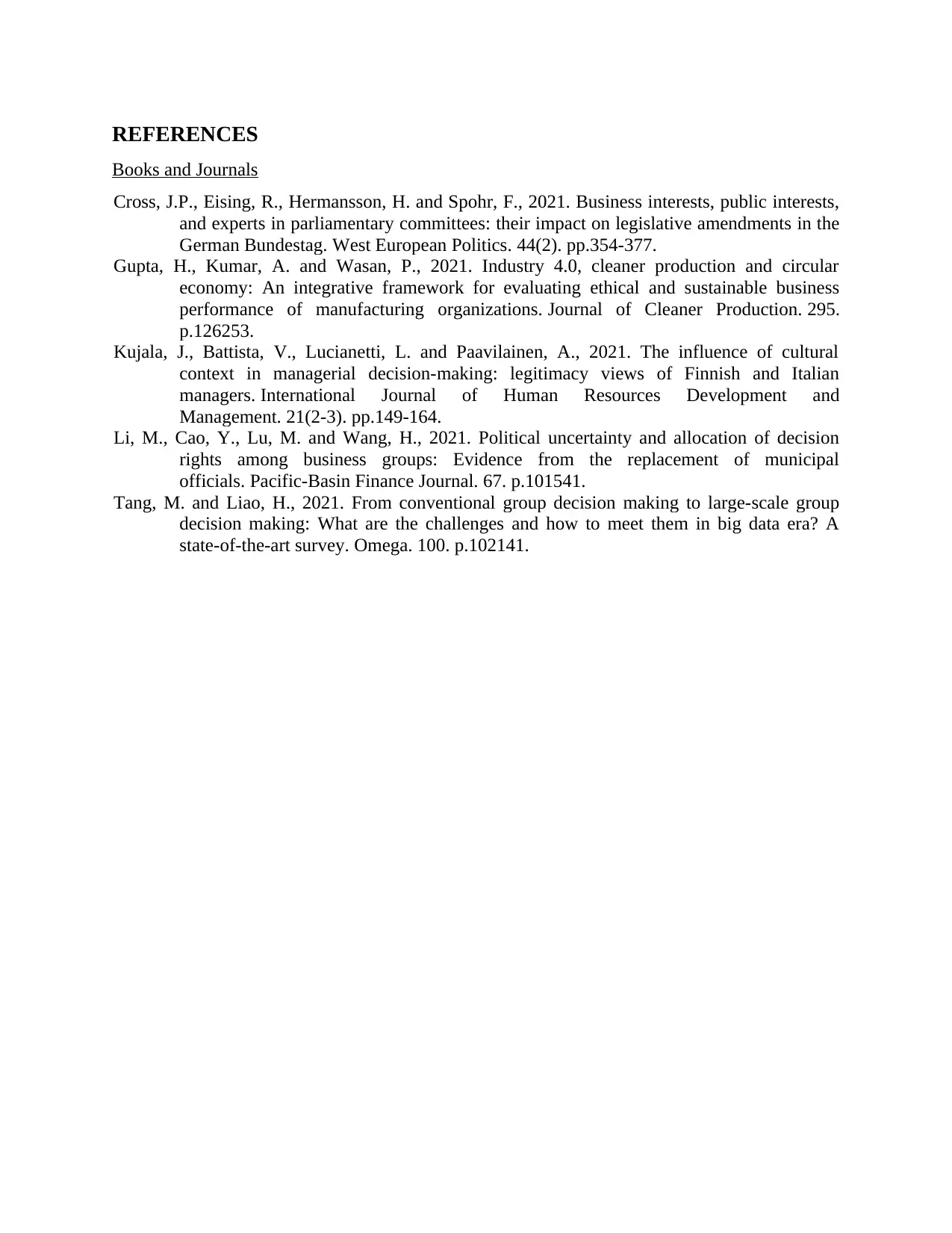Evaluating Business Decisions: Financial and Non-Financial Factors
VerifiedAdded on 2023/06/17
|7
|1511
|142
Essay
AI Summary
This essay explores the application of financial tools in business decision-making, focusing on a case study of AJ plc, a chocolate manufacturing company. The analysis includes the use of the payback period and net present value (NPV) to evaluate potential investments in vegan chocolate or vegan spread production. The report calculates and compares the payback periods and NPVs of both projects, highlighting the importance of considering both financial and non-financial factors, such as market demand and social environment. Ultimately, the essay concludes that while the payback period favors the vegan spread project, the NPV and market demand suggest that investing in vegan chocolate production may be the more viable option for AJ plc. Desklib offers a range of solved assignments and past papers for students.

Essay on Business
Decision-making
Decision-making
Paraphrase This Document
Need a fresh take? Get an instant paraphrase of this document with our AI Paraphraser

Table of Contents
INTRODUCTION ..........................................................................................................................3
TASK ..............................................................................................................................................3
CONCLUSION ...............................................................................................................................6
REFERENCES................................................................................................................................7
INTRODUCTION ..........................................................................................................................3
TASK ..............................................................................................................................................3
CONCLUSION ...............................................................................................................................6
REFERENCES................................................................................................................................7

INTRODUCTION
Business decision making is a series of steps taken up by the management of a business
to take up a course of action to achieve predetermined goals. This step involves setting up
objectives, and goals and then taking up different steps to achieve these goals (Cross, Eising,
Hermansson, and Spohr, 2021). The strategic managers of a business have to choose one plan of
action to go with from a pool of alternatives. This is done by taking help of different tools in
finance and management. Some of them are payback period, net present value etc. that are
discussed in this report. This report highlights the usage of different tools of accounting that are
used by a case business to take their business decisions.
TASK
This report talks about the case study of AJ plc, a chocolate manufacturing company
where the strategic managers of the company are planning to invest in a project which would
either produce vegan chocolates or vegan spread. To aid the strategic managers, a critical
analysis of the factors that influence the decision-making for the organisation are discussed
below. These tools are beneficial to decide which project would pay off more returns on the
investments made and in how much time (Gupta, Kumar, and Wasan, 2021).
Payback Period is the time in which the company will acquire its initial cost of
investment that is made in the project or business (Kujala, Battista, Lucianetti, and Paavilainen,
2021). Every business has many alternatives that they can invest their money in. to aid the
managers, payback period helps them to ascertain in how much time the project will recover the
costs of investment made in this project. The Payback period of both the projects in the case of
AJ plc are calculated below.
Year Annual cash
flow of A
Cumulative cash
flow of A
Annual cash
flow of B
Cumulative cash
flow of B
0 (Initial
Investment)
-140000 -140000 -120000 -120000
1 52000 -88000 46000 -74000
2 58000 -30000 60000 -14000
3 82000 52000 72000 58000
Business decision making is a series of steps taken up by the management of a business
to take up a course of action to achieve predetermined goals. This step involves setting up
objectives, and goals and then taking up different steps to achieve these goals (Cross, Eising,
Hermansson, and Spohr, 2021). The strategic managers of a business have to choose one plan of
action to go with from a pool of alternatives. This is done by taking help of different tools in
finance and management. Some of them are payback period, net present value etc. that are
discussed in this report. This report highlights the usage of different tools of accounting that are
used by a case business to take their business decisions.
TASK
This report talks about the case study of AJ plc, a chocolate manufacturing company
where the strategic managers of the company are planning to invest in a project which would
either produce vegan chocolates or vegan spread. To aid the strategic managers, a critical
analysis of the factors that influence the decision-making for the organisation are discussed
below. These tools are beneficial to decide which project would pay off more returns on the
investments made and in how much time (Gupta, Kumar, and Wasan, 2021).
Payback Period is the time in which the company will acquire its initial cost of
investment that is made in the project or business (Kujala, Battista, Lucianetti, and Paavilainen,
2021). Every business has many alternatives that they can invest their money in. to aid the
managers, payback period helps them to ascertain in how much time the project will recover the
costs of investment made in this project. The Payback period of both the projects in the case of
AJ plc are calculated below.
Year Annual cash
flow of A
Cumulative cash
flow of A
Annual cash
flow of B
Cumulative cash
flow of B
0 (Initial
Investment)
-140000 -140000 -120000 -120000
1 52000 -88000 46000 -74000
2 58000 -30000 60000 -14000
3 82000 52000 72000 58000
⊘ This is a preview!⊘
Do you want full access?
Subscribe today to unlock all pages.

Trusted by 1+ million students worldwide

4 105000 157000 89000 147000
5 118000 275000 108000 255000
Payback Period = The period up to n-1 + cumulative cash flow in n-1 year / Cash inflow
during the nth year
n=year in which cumulative cash flow turned positive
Payback Period of Project A= 2 + 30000 / 82000
= 2 + (0.36*12 months)
= 2+ 4.3
= 2 Years and 4.3 months
Payback period if the company invests in project A is 2 years and 4.3 months.
Payback Period of Project B= 2 + 14000 / 72000
= 2 + (0.19*12 months)
=2 + 2.33
= 2 years and 2.33 months
Payback period if the company invests in project B is 2 years and 2.33 months.
Net Present Value (NPV) is a tool used in accounting that determines the current value
of all future cash flows that are generated by a project (Li, Cao, Lu, and Wang, 2021). This helps
the managers decide which choice of investment the organisation should choose that would give
them the most profit. This measures the profitability of the project. The NPV of the case study is
calculated below:
Calculation of PV cash flow for project A
Cash flows of project PV factor Cash flow/PV factor
52000 0.'901 46852
58000 0.'812 47096
82000 0.'731 59942
105000 0.'659 69195
118000 0.'593 69974
TOTAL 293059
Net Present Value of Project A= 293059 – 140000
5 118000 275000 108000 255000
Payback Period = The period up to n-1 + cumulative cash flow in n-1 year / Cash inflow
during the nth year
n=year in which cumulative cash flow turned positive
Payback Period of Project A= 2 + 30000 / 82000
= 2 + (0.36*12 months)
= 2+ 4.3
= 2 Years and 4.3 months
Payback period if the company invests in project A is 2 years and 4.3 months.
Payback Period of Project B= 2 + 14000 / 72000
= 2 + (0.19*12 months)
=2 + 2.33
= 2 years and 2.33 months
Payback period if the company invests in project B is 2 years and 2.33 months.
Net Present Value (NPV) is a tool used in accounting that determines the current value
of all future cash flows that are generated by a project (Li, Cao, Lu, and Wang, 2021). This helps
the managers decide which choice of investment the organisation should choose that would give
them the most profit. This measures the profitability of the project. The NPV of the case study is
calculated below:
Calculation of PV cash flow for project A
Cash flows of project PV factor Cash flow/PV factor
52000 0.'901 46852
58000 0.'812 47096
82000 0.'731 59942
105000 0.'659 69195
118000 0.'593 69974
TOTAL 293059
Net Present Value of Project A= 293059 – 140000
Paraphrase This Document
Need a fresh take? Get an instant paraphrase of this document with our AI Paraphraser

= 153,059 pounds
The net present value of the investments in project A is 153,059 pounds.
Calculation of PV cash flow for project B
Cash flows of project PV factor Cash flow/PV factor
46000 0.'901 41446
60000 0.'812 48720
72000 0.'731 52632
89000 0.'659 58651
108000 0.'593 64044
TOTAL 265493
Net Present Value of Project B= 265493 – 120000
= 145,493 pounds
The net present value of the investments in project B is 145,493 pounds.
Financial and Non-financial factors also influence the decision-making of the business
in regards to certain projects (Tang and Liao, 2021). This is because there are other factors that
determine whether the business take up a certain project or not. For example, the demand for a
certain commodity in the marketplace will influence the business to take up production and
selling of that product. Financial factors include the funds and monetary requirements of the
projects. Non-financial factors include all the factors of business environment. Social
environment is one of the main factor in this. The strategic managers have to have a deep insight
regarding these factors to come up with the best decision.
Analysis and Decision-making
Payback Period: In the case of payback period, the lesser it is the better. Less payback
period is considered more profitable for the business. This is because, it is the time in which the
business will earn back from the investment, the invested funds/initial investment. By comparing
the payback period of the both alternative, Vegan spread project which is project B has lesser
payback period of 2.2.33 years. Project A has a slightly large payback period in comparison.
Project B is more viable with payback period of 2 years and 2.33 months.
The net present value of the investments in project A is 153,059 pounds.
Calculation of PV cash flow for project B
Cash flows of project PV factor Cash flow/PV factor
46000 0.'901 41446
60000 0.'812 48720
72000 0.'731 52632
89000 0.'659 58651
108000 0.'593 64044
TOTAL 265493
Net Present Value of Project B= 265493 – 120000
= 145,493 pounds
The net present value of the investments in project B is 145,493 pounds.
Financial and Non-financial factors also influence the decision-making of the business
in regards to certain projects (Tang and Liao, 2021). This is because there are other factors that
determine whether the business take up a certain project or not. For example, the demand for a
certain commodity in the marketplace will influence the business to take up production and
selling of that product. Financial factors include the funds and monetary requirements of the
projects. Non-financial factors include all the factors of business environment. Social
environment is one of the main factor in this. The strategic managers have to have a deep insight
regarding these factors to come up with the best decision.
Analysis and Decision-making
Payback Period: In the case of payback period, the lesser it is the better. Less payback
period is considered more profitable for the business. This is because, it is the time in which the
business will earn back from the investment, the invested funds/initial investment. By comparing
the payback period of the both alternative, Vegan spread project which is project B has lesser
payback period of 2.2.33 years. Project A has a slightly large payback period in comparison.
Project B is more viable with payback period of 2 years and 2.33 months.

Net Present Value: NPV shows the current value of their investments in response to
future. The cash flows are analysed in this. The higher the NPV is, the more desirable the project
becomes. The above calculation of NPV of the two alternatives shows that the project A also has
higher NPV which makes project A, Vegan chocolates more desirable and profitable for the
business. Project B has slightly less NPV.
Project A is more viable with NPV amounting 153,059 pounds
Financial and Non-financial factors: The influence of these factors in decision-making in
the case of AJ plc are, the social factors like the needs and wants of the consumers. The study of
2019 shows that there have been a significant market growth in the demand of vegan chocolates
due to the changing preferences of the consumers.
Project A is more viable after analysing the above-mentioned factors.
CONCLUSION
From the above mentioned report it can be concluded that different tools helps in
decision-making of a business. These tools include payback period, net present value, other
financial and non-financial factors of decision-making. The report mainly talks about the case of
AJ plc and how the managers of this organisation wants to invest in one of the alternative of
vegan products. If AJ plc goes with the payback period, project B is more viable as the return
rate in that project is faster. If the company takes up NPV as the decision factor then project A is
more viable as the return in that project is greater than other project. If non-financial factors are
taken up then vegan chocolates is more demanding in the market, hence AJ plc should go with
project A.
future. The cash flows are analysed in this. The higher the NPV is, the more desirable the project
becomes. The above calculation of NPV of the two alternatives shows that the project A also has
higher NPV which makes project A, Vegan chocolates more desirable and profitable for the
business. Project B has slightly less NPV.
Project A is more viable with NPV amounting 153,059 pounds
Financial and Non-financial factors: The influence of these factors in decision-making in
the case of AJ plc are, the social factors like the needs and wants of the consumers. The study of
2019 shows that there have been a significant market growth in the demand of vegan chocolates
due to the changing preferences of the consumers.
Project A is more viable after analysing the above-mentioned factors.
CONCLUSION
From the above mentioned report it can be concluded that different tools helps in
decision-making of a business. These tools include payback period, net present value, other
financial and non-financial factors of decision-making. The report mainly talks about the case of
AJ plc and how the managers of this organisation wants to invest in one of the alternative of
vegan products. If AJ plc goes with the payback period, project B is more viable as the return
rate in that project is faster. If the company takes up NPV as the decision factor then project A is
more viable as the return in that project is greater than other project. If non-financial factors are
taken up then vegan chocolates is more demanding in the market, hence AJ plc should go with
project A.
⊘ This is a preview!⊘
Do you want full access?
Subscribe today to unlock all pages.

Trusted by 1+ million students worldwide

REFERENCES
Books and Journals
Cross, J.P., Eising, R., Hermansson, H. and Spohr, F., 2021. Business interests, public interests,
and experts in parliamentary committees: their impact on legislative amendments in the
German Bundestag. West European Politics. 44(2). pp.354-377.
Gupta, H., Kumar, A. and Wasan, P., 2021. Industry 4.0, cleaner production and circular
economy: An integrative framework for evaluating ethical and sustainable business
performance of manufacturing organizations. Journal of Cleaner Production. 295.
p.126253.
Kujala, J., Battista, V., Lucianetti, L. and Paavilainen, A., 2021. The influence of cultural
context in managerial decision-making: legitimacy views of Finnish and Italian
managers. International Journal of Human Resources Development and
Management. 21(2-3). pp.149-164.
Li, M., Cao, Y., Lu, M. and Wang, H., 2021. Political uncertainty and allocation of decision
rights among business groups: Evidence from the replacement of municipal
officials. Pacific-Basin Finance Journal. 67. p.101541.
Tang, M. and Liao, H., 2021. From conventional group decision making to large-scale group
decision making: What are the challenges and how to meet them in big data era? A
state-of-the-art survey. Omega. 100. p.102141.
Books and Journals
Cross, J.P., Eising, R., Hermansson, H. and Spohr, F., 2021. Business interests, public interests,
and experts in parliamentary committees: their impact on legislative amendments in the
German Bundestag. West European Politics. 44(2). pp.354-377.
Gupta, H., Kumar, A. and Wasan, P., 2021. Industry 4.0, cleaner production and circular
economy: An integrative framework for evaluating ethical and sustainable business
performance of manufacturing organizations. Journal of Cleaner Production. 295.
p.126253.
Kujala, J., Battista, V., Lucianetti, L. and Paavilainen, A., 2021. The influence of cultural
context in managerial decision-making: legitimacy views of Finnish and Italian
managers. International Journal of Human Resources Development and
Management. 21(2-3). pp.149-164.
Li, M., Cao, Y., Lu, M. and Wang, H., 2021. Political uncertainty and allocation of decision
rights among business groups: Evidence from the replacement of municipal
officials. Pacific-Basin Finance Journal. 67. p.101541.
Tang, M. and Liao, H., 2021. From conventional group decision making to large-scale group
decision making: What are the challenges and how to meet them in big data era? A
state-of-the-art survey. Omega. 100. p.102141.
1 out of 7
Related Documents
Your All-in-One AI-Powered Toolkit for Academic Success.
+13062052269
info@desklib.com
Available 24*7 on WhatsApp / Email
![[object Object]](/_next/static/media/star-bottom.7253800d.svg)
Unlock your academic potential
Copyright © 2020–2025 A2Z Services. All Rights Reserved. Developed and managed by ZUCOL.



